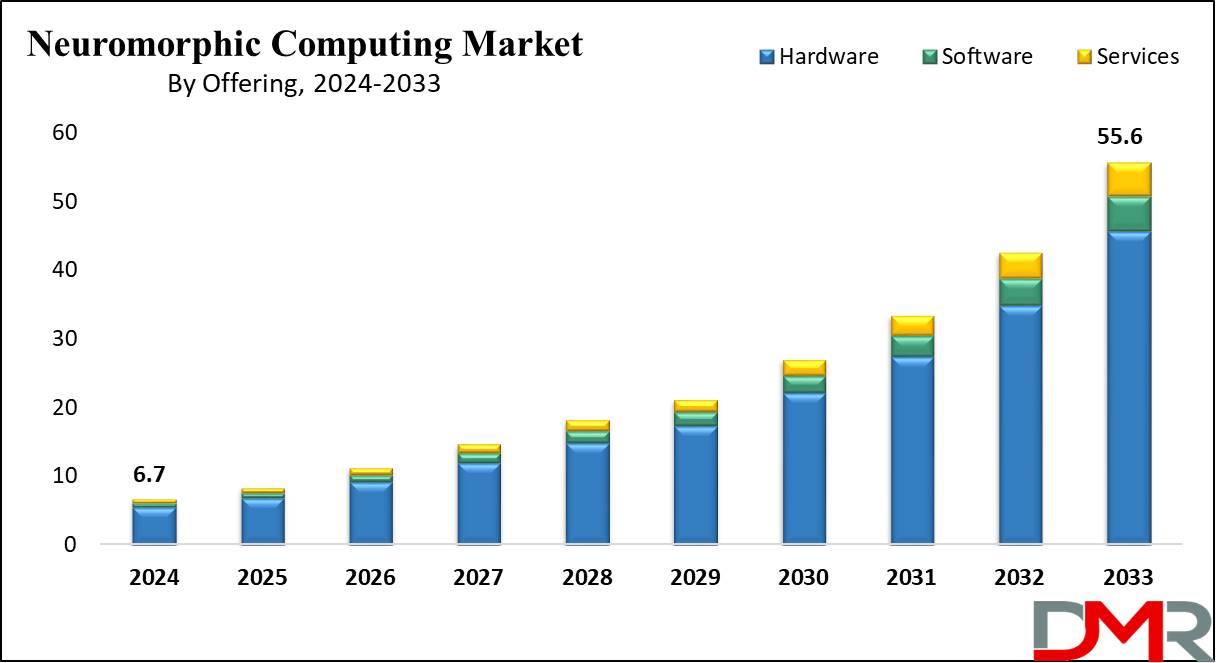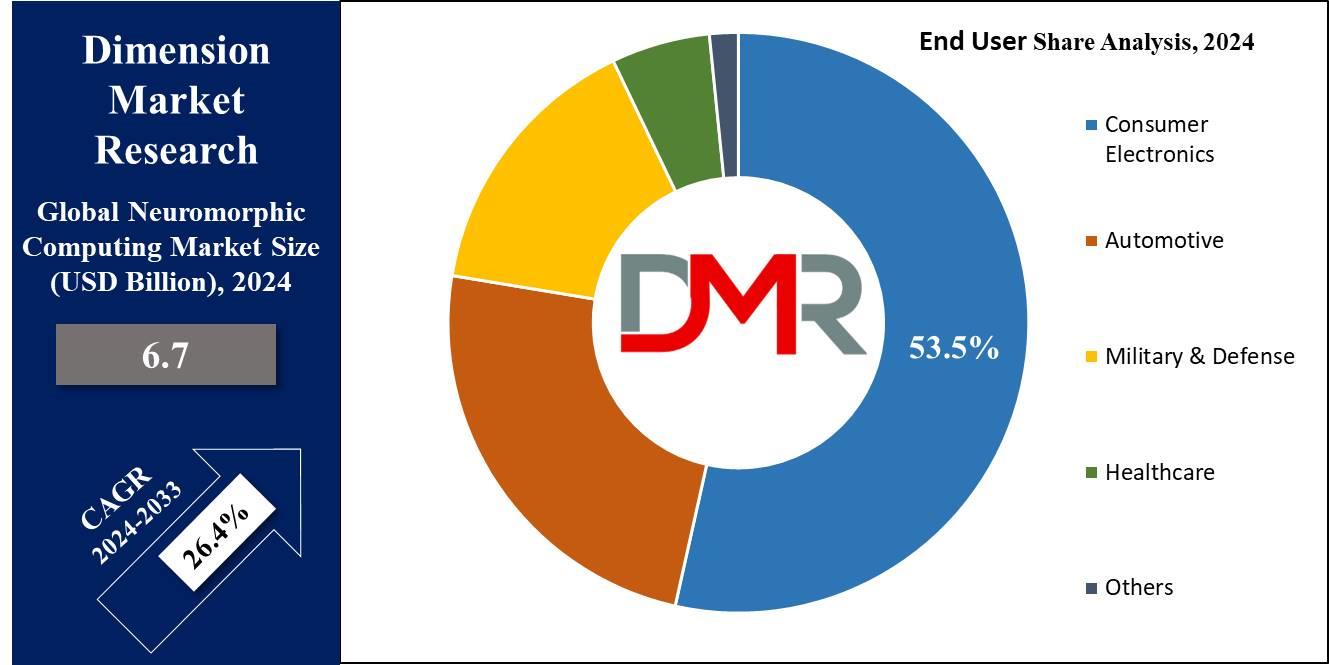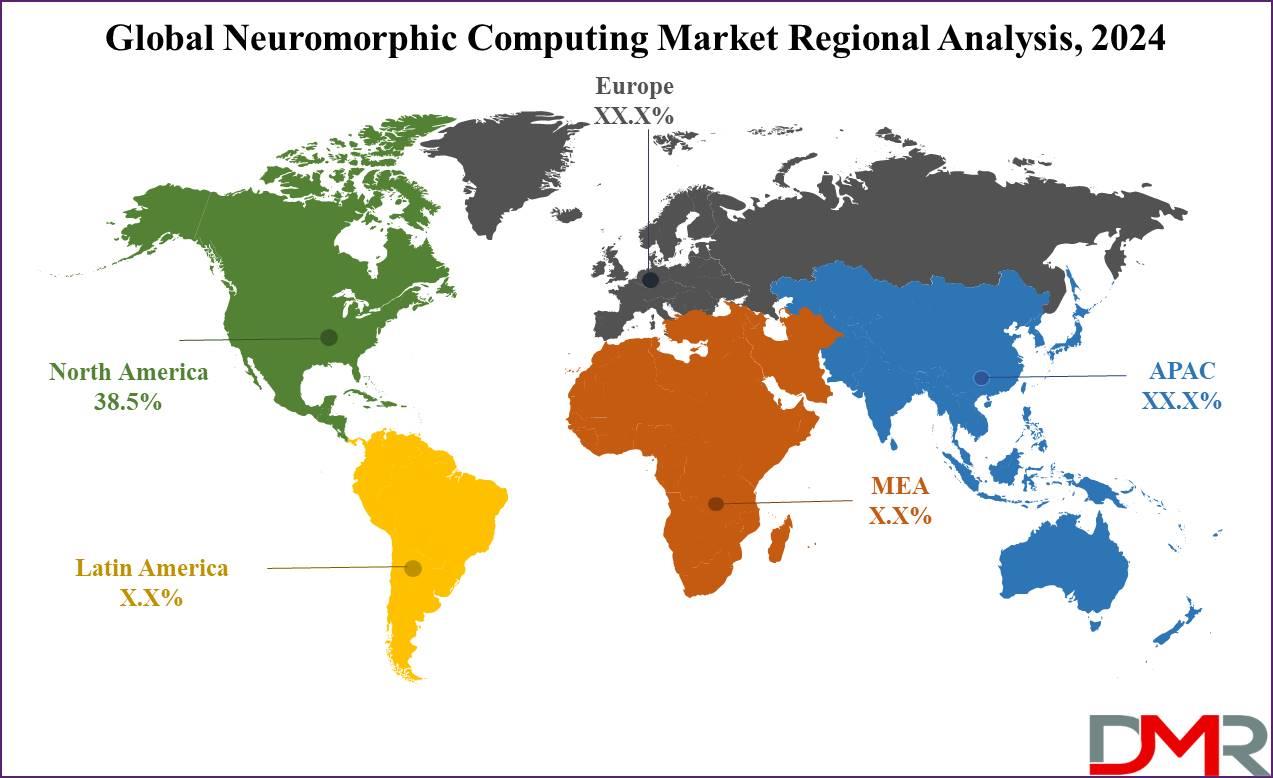(MENAFN- GlobeNewsWire - Nasdaq) In the coming years, neuromorphic computing is anticipated to transform AI by offering energy-efficient, brain-inspired processing. Its applications in robotics, autonomous systems, healthcare, and biometrics will expand significantly. While challenges like high development costs & lack of standardization persist, ongoing research, government support, and developments in AI will drive its broader adoption and innovation.New York, Nov. 18, 2024 (GLOBE NEWSWIRE) -- Overview :
The Neuromorphic Computing market size is expected to reach USD 6.7 billion by 2024 and is further anticipated to reach USD 55.6 billion by 2033 according to Dimension Market Research. The market is anticipated to register a CAGR of 26.4% from 2024 to 2033.
Neuromorphic computing is the development of computing systems modeled after the architecture & functions of the human brain. These systems attempt to replicate neurological processes to conduct computations more effectively & adaptively. Unlike standard computing models that depend on von Neumann architectures, neuromorphic computing processes information in a biologically inspired manner using neural networks, analog circuits, and specialized hardware, which is mainly beneficial in applications that need pattern recognition, sensory processing, and real-time decision-making.
Click to Request Sample Report and Drive Impactful Decisions:

The US Overview
The Neuromorphic Computing Market in the US is projected to reach USD 2.3 billion in 2024 at a compound annual growth rate of 24.7% over its forecast period.
The US neuromorphic computing market is expanding due to developments in AI, robotics, and key sectors like the military, healthcare, and AI-driven speech recognition. Government funding, research, & industry-academic collaboration drive innovation. However, high development costs, hardware complexity, and a lack of standardized frameworks create challenges to adoption and integration into existing systems.
Important Insights
The Neuromorphic Computing Market is expected to grow by USD 47.3 billion by 2033 from 2025 with a CAGR of 26.4%. The hardware segment is anticipated to dominate in 2024 with a majority & is projected to lead throughout the forecasted period.
The image processing segment is set to be leading the market in 2024. The consumer electronics segment is projected to get the biggest revenue share in 2024 in the Neuromorphic Computing Market. North America is set to have a 38.5% share of revenue share in the Global Neuromorphic Computing Market in 2024.
Global Neuromorphic Computing Market: Trends
AI-Driven Applications : The growing integration of neuromorphic chips in AI-powered technologies such as speech and image recognition. Energy-Efficient Computing : The increasing focus on low-power, high-efficiency neuromorphic systems for energy-constrained environments. Autonomous Systems Adoption : The growth in deployment of neuromorphic solutions in autonomous robots, drones, and vehicles. Biometric Advancements : The higher use of neuromorphic computing in biometric applications, improving facial recognition and security systems.
Neuromorphic Computing Market: Competitive Landscape
Neuromorphic computing, inspired by the brain, is developing rapidly as research labs and tech companies develop energy-efficient chips to improve AI. With applications in robotics, smart sensors, and autonomous systems, competition is very strong. While progress is promising, broader adoption remains in its early stages as companies explore practical uses that surpass traditional AI methods.
Some of the major players in the market include IBM Corp, Intel Corp, Qualcomm Technologies, General Vision Inc, Brain Corporation, Samsung Electronics, and more.
Some of the prominent market players:
IBM Corp Intel Corp Qualcomm Technologies General Vision Inc Brain Corporation Samsung Electronics Known Inc Hewlett Packard Company Vicarious Applied Brain Research Other Key Players
Transform your business approach with strategic insights from our report. Get in touch to request our brochure today at
Neuromorphic Computing Market Scope
| Report Highlights | Details |
| Market Size (2023) | USD 6.7 Bn |
| Forecast Value (2032) | USD 55.6 Bn |
| CAGR (2023-2032) | 26.4% |
| The US Market Size (2024) | USD 2.3 Bn |
| Leading Region in terms of Revenue Share | North America |
| Percentage of Revenue Share by Leading Region | 38.5% |
| Historical Data | 2018 - 2023 |
| Forecast Data | 2024 - 2033 |
| Base Year | 2023 |
| Estimate Year | 2024 |
| Segments Covered | By Offering, By Deployment, By Application, By End User |
| Regional Coverage | North America, Europe, Asia Pacific, Latin America, Middle East & Africa (MEA) |
Segment Analysis:
The neuromorphic computing market spans industries including automotive, healthcare, consumer electronics, manufacturing, aerospace & defense, and others. Among these, consumer electronics is anticipated to hold the largest market share due to the broad usage of laptops, smartphones, tablets, and wearables. In addition, in the automotive sector, the highest growth rate is projected, as neuromorphic technology improves AI and machine learning applications like autonomous driving and image recognition, driving innovation in smart vehicles.

Neuromorphic Computing Market Segmentation
By Offering
Hardware Software Services
By Deployment
Edge Computing Cloud Computing
By Application
Signal Processing Image Processing Data Processing Object Detection Others
By End User
Consumer Electronics Automotive Military & Defense Healthcare Others
Purchase the Competition Analysis Dashboard Today at
Global Neuromorphic Computing Market: Driver
AI Advancements : Growth is driven by innovations in AI, improving neuromorphic computing's potential in tasks like speech & image recognition. Energy Efficiency : Neuromorphic systems provide significant energy savings, appealing to industries demanding efficient data processing. Autonomous Systems : Higher demand for autonomous technologies, like robotics and self-driving vehicles, fuels market growth. Government Support : Funding & research initiatives from governments and collaborations with academia are accelerating development and commercialization efforts.
Global Neuromorphic Computing Market: Restraints
High Development Costs : The complexity & expense of developing neuromorphic hardware impact the broad adoption. Lack of Standardization : The absence of standardized frameworks complicates integration with existing systems. Hardware Complexity : Neuromorphic systems require specialized hardware, making development and scaling more challenging. Limited Commercial Applications : Neuromorphic computing is still in its early stages, with limited proven commercial applications compared to traditional AI technologies.
Global Neuromorphic Computing Market: Opportunities
AI Integration : The increase in opportunities for improving AI applications like speech and image recognition through neuromorphic computing. Autonomous Systems : Large use in robotics, autonomous vehicles, and smart sensors presents a major market opportunity. Healthcare Innovations : Neuromorphic computing provides potential breakthroughs in medical diagnostics and brain-computer interfaces. Biometric Technologies : The growing demand for advanced biometric systems, main in security and authentication, drives opportunities in neuromorphic computing.
Click to Request Sample Report and Drive Impactful Decisions at
Regional Analysis
North America is expected to dominate the neuromorphic computing market, accounting for about 38.5% of revenue in 2024. The US and Canada, leading adopters, dominate in integrating neuromorphic systems, driven by the growth of AI-based voice and speech recognition technologies that improves accuracy. As a result, the need for neuromorphic computing is increasing across the region. Europe is also set for major growth, with higher adoption of biometric technologies, mainly in image processing. Research & development efforts are increasing the use of neuromorphic systems, positioning Europe as a key player globally.

By Region
North America
Europe
Germany The U.K. France Italy Russia Spain Benelux Nordic Rest of Europe
Asia-Pacific
China Japan South Korea India ANZ ASEAN Rest of Asia-Pacific
Latin America
Brazil Mexico Argentina Colombia Rest of Latin America
Middle East & Africa
Saudi Arabia UAE South Africa Israel Egypt Rest of MEA
Recent Developments in the Neuromorphic Computing Market
September 2024: IISc researchers announced that they designed a brain-inspired analog computing platform with the ability to store & process data in a large 16,500 conductance states within a molecular film. July 2024: The European Union & the Republic of Korea reported that they will be supporting four jointly funded projects in semiconductors as a deliverable of the EU-Republic of Korea Digital Partnership, which will develop heterogeneous integration technologies. May 2024: SpiNNcloud Systems GmbH launched SpiNNaker2 platform, a supercomputer-level hybrid AI high-performance computer system based on principles of the human brain, by using a large number of low-power processors to compute AI and other workloads efficiently. April 2024: Intel announced that it built the world's biggest neuromorphic system called as Hala Point, installed at Sandia National Laboratories, using Intel's Loihi 2 processor, aimed on assisting research for future brain-inspired artificial intelligence (AI), and resolving challenges related to the efficiency and sustainability of current AI. April 2024: KAIST researchers launched the creation of a low-power, affordable phase change memory device that can be used to substitute existing memory or used in implementing neuromorphic computing for next-generation AI hardware for its low processing costs & ultra-low power consumption.
Browse More Related Reports
The Global Data Integration Software Market size is expected to reach a value of USD 7.3 billion in 2024, and it is further anticipated to reach a market value of USD 20.1 billion by 2033 at a CAGR of 11.9%.
The Global Cloud Services Market size is expected to reach a value of USD 644.5 billion in 2024, and it is further anticipated to reach a market value of USD 2,466.1 billion by 2033 at a CAGR of 16.1%.
The Global Artificial Intelligence in Breast Imaging Market size is expected to reach a value of USD 7,913.1 million in 2024, and it is further anticipated to reach a market value of USD 85,443.3 million by 2033 at a CAGR of 30.4%.
The Global Advanced Robotics Market is forecasted to reach USD 47.5 billion by the end of 2024 and grow to USD 260.9 billion in 2033, with a CAGR of 20.8% .
Global Space Tourism Market is forecasted to reach USD 1,313.8 million by the end of 2024 and is predicted to grow to USD 40,399.0 million in 2033 with a CAGR of 46.3%.
Global Voice and Speech Recognition Market is forecasted to reach USD 24.6 billion by the end of 2024 and is predicted to grow to USD 87.6 billion in 2033 with a CAGR of 15.1%.
Global Sponge Counting System Market is projected to reach USD 198.9 million by the end of 2024 and grow exponentially to an anticipated value of USD 358.1 million in 2033 at a CAGR of 6.8%.
The Global Digital Twin Market is forecasted to reach USD 24.3 billion by the end of 2024 and grow to USD 412.0 billion in 2033, with a CAGR of 36.9%.
The Global Green Technology & Sustainability Market is forecasted to reach USD 29.0 billion by the end of 2024 and grow to USD 193.9 billion in 2033, with a CAGR of 23.5%.
The Global Nanotechnology Market is forecasted to reach USD 5.3 billion by the end of 2024 and grow to USD 74.9 billion in 2033, with a CAGR of 34.3%.
About Dimension Market Research (DMR) :
Dimension Market Research (DMR) is a market research and consulting firm based in India & US, with its headquarters located in the USA (New York). The company believes in providing the best and most valuable data to its customers using the best resources analysts into work, to create unmatchable insights into the industries, and markets while offering in-depth results of over 30 industries, and all major regions across the world. We also believe that our clients don't always want what they see, so we provide customized reports as well, as per their specific requirements to create the best possible outcomes for them and enhance their business through our data and insights in every possible way.
CONTACT: Contact Us:
Website -
Email- ...
Call us- +1 732 369 9777, +91 88267 74855

MENAFN18112024004107003653ID1108898174
Legal Disclaimer:
MENAFN provides the information “as is” without warranty of any kind. We do not accept any responsibility or liability for the accuracy, content, images, videos, licenses, completeness, legality, or reliability of the information contained in this article. If you have any complaints or copyright issues related to this article, kindly contact the provider above.